Summary
- Audiences can be simpler today than they used to be due to Smart Bidding
- Feed-based ads are easier to create at scale but can be less efficient for D2C eCommerce
- Discovery Ads with Feeds is a must for eCommerce businesses
- Using lifestyle images and short titles for Discovery Ads is a must
- Retargeting campaigns still make sense in the day of Performance Max
Intro
Retargeting isn’t for every eCommerce business. I think it’s largely overrated for retail stores and underrated for direct-to-consumer brands.
The biggest advantage of retargeting is that you get to show your brand and ad messaging to highly motivated consumers who have already been to your site.
But there are many ways to do it, and just because someone has been to your site once doesn’t mean they are worth being shown ads over and over again.
Clicking the wrong link on Facebook doesn’t mean you get anything out of that person. Today, we will discuss this and many more aspects of running a successful retargeting campaign for eCommerce.
Note: Performance Max is already showing on this inventory. If you aren’t running Performance Max or you’ve stripped it of assets, you are not shown on most of these assets mentioned today. For more details on whether standalone remarketing campaigns are worth it if you are running Performance Max, jump to the end.
Discovery Ads & Traditional Display Ads
Besides the traditional Display Ads we all know, there is also a campaign type called Discovery Ads.

Discovery Ads is the new kid on the block when it comes to display advertising for eCommerce, as it has just acquired the ability to include a Google Merchant Center feed in it. It’s been in beta for a while but was released in the summer of 2022.
It currently shows up in three main parts of the Google Ad Inventory:
- Gmail as “promotional” emails (desktop & mobile)
- YouTube in the Home and “Watch Next” feeds (mobile only)
- The Discover section of Google (mobile only)
Discovery Ads is a great addition to regular Display ads and allows you access to ad inventory you wouldn’t otherwise have access to.
Today, we will discuss the following:
- How to create ads (feed-based or Responsive Display Ads)
- How to structure your campaigns
- Audience targeting
- Bidding & performance management
But first, let’s discuss why it’s good to include your feed for your eCommerce retargeting.
Include Your Feed for Powerful Retargeting Options
Adding your feed to generate ads will do two things:
- It will show ads for the product a consumer viewed on your site.
- It will create dynamic ad assets based on those products.
Both are really useful when you need to scale retargeting. Later in this article, I will go into detail about whether this is the best way to run retargeting ads for all advertisers (hint: it’s not).
Two things that aren’t ideal about your regular Google Shopping feed are the title and images.
You can do two things about this:
- Use a separate feed for your Display Ads.
- Use the feed attributes short_title and lifestyle_image_link (only applicable to Discovery Ads).
Differentiate Titles & Images for Discovery Ads
I absolutely love this from Google. I’m generally skeptical about new things from Google, but this little thing here is a gem.
Normally, we create product titles in our feeds that are heavily search intent–focused. We use brand, category, product name, model series, size, color, and material in the title. Heck, Google even takes attributes and adds them to the title dynamically now.
But that’s not the best way to go about it for Display.
So Google introduced the ability to create shorter titles and set different images for your display ads using two attributes:
This allows you to take the dull images used for Shopping and keyword-stuffed titles and create something more styled for Display.
Remove this:
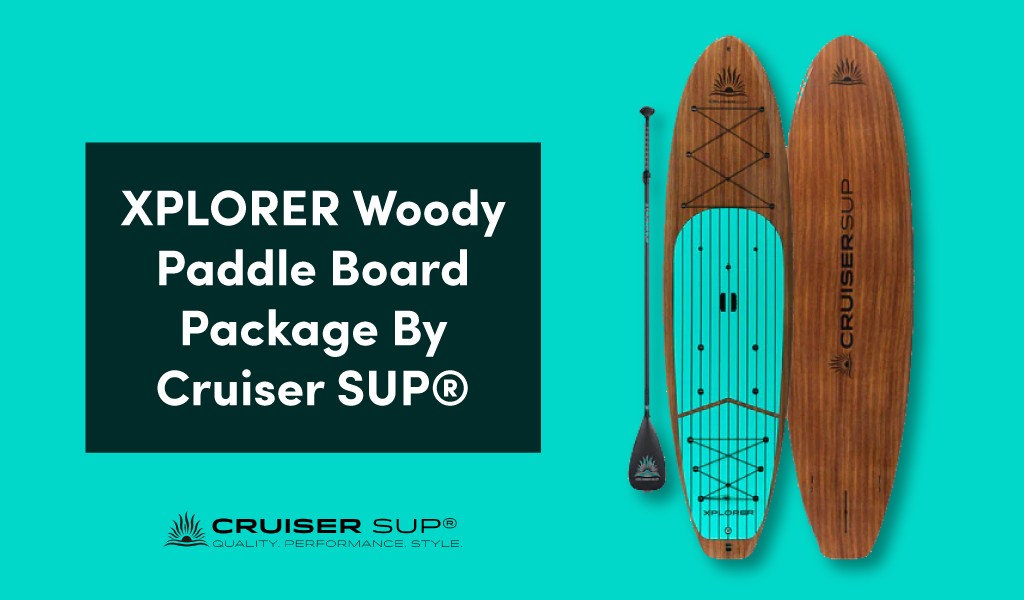
Text: XPLORER Woody Paddle Board Package by Cruiser SUP®
Image link: https://www.cruisersup.com/products/xplorer-stand-up-paddle-boards
And instead run this:

Text: Premium Non-inflatable Paddle Boards by Cruiser SUP®
Image link: https://www.cruisersup.com/pages/stand_up_paddle_boards
Which do you think will work best for display advertising?
For me, this constitutes a game-changer for feed-based display advertising and is a must for Discovery campaigns. And when it’s finally used for all Display campaigns, I think it will be great.
With that out of the way, I want to touch on when it’s a good idea to run feed-based Display ads and when you should use Responsive Display Ads with customized images.
Ad Creation: Feed-Based vs. Custom Creative
Feed-based is the easy first step, and it’s ideal for retail stores in the long run. The positive side is that you can start running personalized ads without doing much.
A user sees a product, and then you show ads for that specific product around the web.
So far, so good.
But what if the ad itself needs to be improved? What if it needs to touch on some of the pain/friction points that potential customers experience before they buy your product?
That’s where Responsive Display Ads come into play.
You can add more custom ad assets, like
- Text
- Images
- Videos
that touch on the specific pain points of your users rather than merely showing the same product over and over again.
What’s the Best Landing Page?
Another aspect of whether to choose feed-based ads or not is where you want to link the users to. When you run feed-based, it’s the product page—but again, is it ideal to have users read a product page over and over again, or is it better to build a custom landing page with specific pain points?
For retail stores with thousands of products, 90% of the retargeting efforts will and should be feed-based. It’s simply impossible to create audiences and Responsive Display Ads for all products.
But for D2C eCommerce, this question is more 50/50.
Product/Campaign Segmentation
Some products are better suited for retargeting than others, and no matter how many SKUs you carry, you need to do some product segmentation and thereby campaign segmentation.
Let’s take the example of a company that sells training shoes, like NoBull:

Their main products are training and running shoes, but they also sell accessories. There can be tremendous value in pushing retargeting for their core products, but not for socks, wristbands, swim caps, etc.
So consider two things when creating campaign segmentations:
- Do you want to advertise all your products?
- Do you need to differentiate the ROAS targets?
Examples of campaign structure:
- D: Main | 7–90 days | ROAS 500%
- D: Main | 0–7 days | ROAS 250%
- D: Accessories | Excluded
In the example above, we have created a campaign structure that allows us to:
- Run more aggressively for consumers who have visited our site in the last 7 days
- Still advertise over the 7–90-day period, but we need to have a higher ROAS and subsequently tell Smart Bidding not to bid as aggressively here
- Exclude accessories from any remarketing advertising
And now it comes to how you structure your audiences, which we’ll talk about next.
Audience Targeting
First off, as one of the old guys in the industry, I used to create audiences segmented on 7, 14, 21, 28 days, etc. to bid accordingly.
That’s no longer necessary (if you use Smart Bidding).
Google can read “inside” your audience lists. If you create lists of 540 days, then Smart Bidding can bid according to how long someone has been on your list and how well these cohorts usually convert (source).
It’s about how Smart Bidding will bid for the actual search term, not the keyword, for Search campaigns.
Therefore, there is no need to create individual audiences based on duration for performance purposes.
But if you are like me and you like to have some insight into how your audiences are running, then I still recommend doing a recent audience and a total audience.
- Recent audience refers to the typical customer journey—i.e., the last 7, 14, or 28 days.
- Total audience refers to as much data as you have—e.g., 540 days.
It’s hard to say exactly how many people should be in your audiences before retargeting campaigns are worthwhile. As they are quick to create, they tend to be worth it for most, regardless of the business size, but obviously, the more traffic you have on your website, the more effective your retargeting campaigns will be.
The Audiences You Should Create
Again, my approach these days is to simplify rather than create overly granular targeting options that we aren’t going to use anyway.
For eCommerce, the typical audiences you should create for retargeting are:
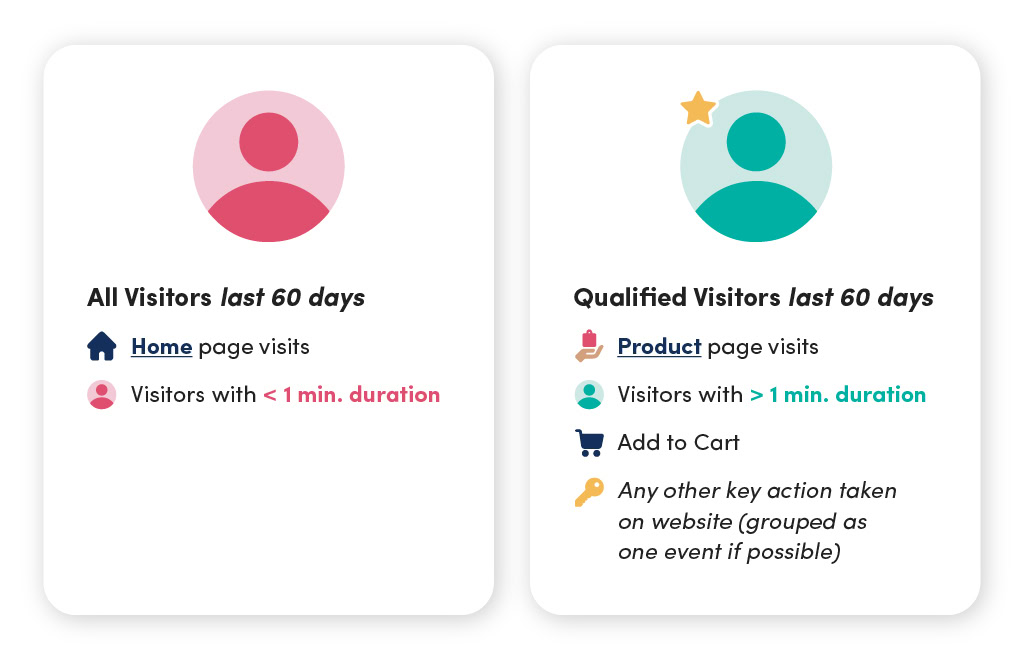
- All visitors in the last 60 days
- Home page visits
- Visits of <1 min in duration
- Qualified visitors in the last 60 days
- Visits of >1 min in duration
- Product page visits
- Add to Cart
- Any other key action taken on the website (grouped as one event if possible)
The one-minute site visit duration and the duration that determines whether users should be on your audience lists are both relative. Using your own data, you should figure out what the ideal setting is for your retargeting audience. The key is not to be overly restrictive, but not to advertise to every person whose slightly pudgy finger clicked the wrong ad, either.
Granted, if you run manual bidding, then you should still split up the audiences into durations for bidding purposes.
Optimized Targeting: A Great Expansion Opportunity, Or?
Google recommends going with optimized targeting enabled.
I don’t disagree. But I don’t think you should start off doing that.
I like the following ramp-up period:
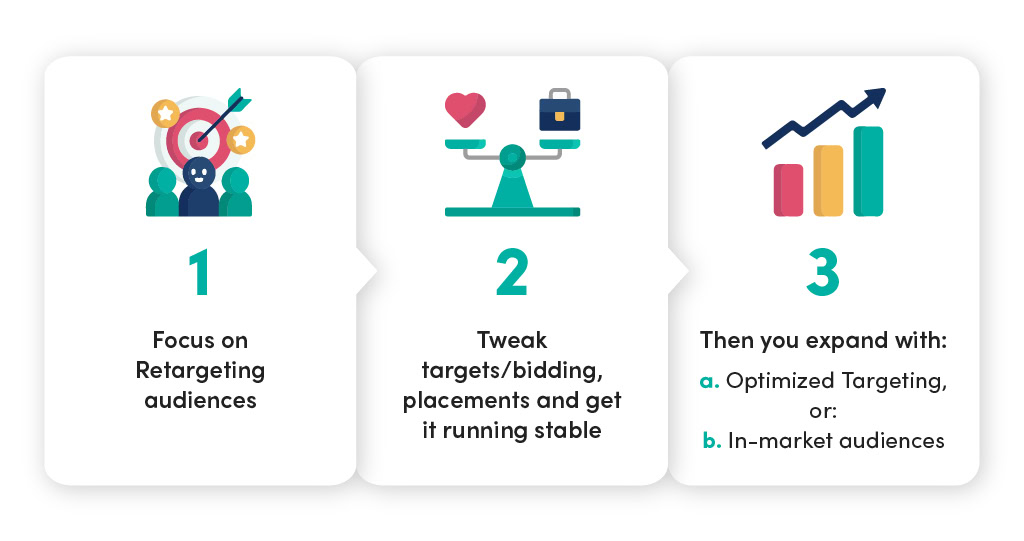
- Focus on retargeting audiences.
- Tweak targets/bidding and placements and get it running stably.
- Then expand with:
- optimized targeting or
- in-market audiences.
Jumping straight into using optimized targeting often overrides the budget going to your retargeting audiences, and you initially don’t launch these campaigns as regular display campaigns. You are doing it for retargeting purposes.
By enabling optimized targeting, you go from a retargeting campaign to a general display campaign. That doesn’t have to be a bad thing, but I recommend that you initially stick with just retargeting.
Bidding & Performance Evaluation
I find evaluating ROAS from a remarketing campaign difficult. I agree that we should always have some sort of performance target, but I can also see value in showing my products on a regular basis to consumers who have visited my website. The good old seven touches theory about advertising is even more relevant today than ever.
If you are not familiar with the concept, it’s about the need to show your ads/message to a consumer seven times, on average, before they remember you (or take action).
Considering this, you shouldn’t expect to generate a ROAS from every retargeting click/impression.
At the same time, you can’t ignore the fact that you simply get better performance from using Smart Bidding (ROAS or CPA).
Which again contradicts the fact that I’m fundamentally against using any kind of “maximize clicks” bidding methodology, as it means you are buying the lowest-quality clicks. Just because we don’t want to use ROAS as our final measurement of whether our retargeting campaigns are a good investment doesn’t mean we should ignore any quality factors at all.
So, in my opinion, Smart Bidding is still the way to go when it comes to bidding and evaluation performance from Remarketing campaigns.
Bidding Should Be Smart Bidding
But your target doesn’t have to be a “breakeven” ROAS target. Too many advertisers try to calculate every single marketing campaign down to its breakeven point, and that is what determines the ROAS target you set.
But that defeats the point. What if consumers click our remarketing ads but end up converting after clicking a brand ad? Well, a lot less of the value goes to our retargeting campaigns. That’s not exactly fair.
I highly recommend our article on blended ROAS for a more in-depth discussion of how to evaluate performance from your marketing efforts—including retargeting.
The gist is that you shouldn’t use your breakeven point to determine your ROAS target.
For retargeting, it might be a good place to start, but if you have a long consumer journey, you might want to reduce your ROAS target for retargeting to maximize your ad exposure for these highly relevant consumers.
On the opposite side of the spectrum, if you are a large electronics retailer selling cables, then retargeting might not be something you value beyond a day or so. But even then, you want everything to be performance-driven.
“Attribution Model”
We can’t discuss performance without discussing attribution models. Are we using last click? Data-driven? Position-based?
No matter what attribution model you use, you need to realize that it doesn’t accurately show attribution. The system only shows what it can track itself, and if you use a data-driven model (which is the default today), you don’t know if it accredits 90% or 10% of the value to a retargeting campaign.
That’s a problem.
Personally, I like to set up separate Google Ads accounts for brand terms and Display retargeting.
Granted, this is more time-consuming to set up, and you might end up with missing data issues. But IMO, most accounts do not lose out massively from at least moving retargeting campaigns to a separate account.
The idea behind doing this is to maximize the data for each type of touchpoint in the consumer’s journey. You then assign budgets and ROAS targets based on this data instead of Google doing it behind the scenes.
Performance Max vs. Standalone Retargeting Campaigns
As Performance Max makes its march against all eCommerce accounts, it’s worth discussing whether you need to run standalone retargeting campaigns.
The whole reason Performance Max was created was that advertisers wouldn’t have to create individual campaigns to hit various parts of Google’s ad inventory.
My overall opinion is that if you are running Performance Max fully (with streamlined asset groups, defined assets, continuous optimization, and targeted audiences), then there shouldn’t be much need for standalone display campaigns.
If you are not running Performance Max, then you should absolutely use the campaign structure described in this article.
The case for running individual display retargeting campaigns while running Performance Max is the same as always: you don’t know what’s going on inside Performance Max.
Is 2% or 20% of your spend retargeting focused?
We often talk about this in terms of Performance Max overspending on retargeting audiences, but the opposite can easily be the case. If you don’t know, you don’t know.
Running standalone Display retargeting campaigns can be a failsafe to ensure that Performance Max is not missing any opportunities.
Conclusion
To summarize, I believe that creating retargeting campaigns for Display is a must for most eCommerce businesses, but take it with a grain of salt if you are a large retail eCommerce business.
There shouldn’t be a reason not to create at least Discovery Ads for retargeting, even if it is just to get access to advertising in people’s Gmail inboxes.
Not a lot of other ads appear there, and by doing the basics right, you can stand out greatly.
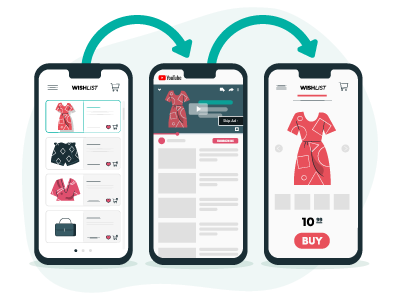
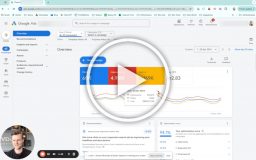





12 thoughts on “Display Retargeting: The Efficient Setup for eCommerce”
Hey Andrew, Great post!
Quick question about the sequenced ad serving. I am not sure how you accomplish that. Also what is your campaign structure? Ad groups based on remarketing lists?
Thanks!
Thanks, Philip!
It’s a bit tricky. You need to create several remarketing lists in different durations. Then you create new campaigns, where you add the 60 day remarketing list as the target and the 30 day remarketing list as the exclusion. That way you only target the people in 30-60 days.
Ad groups are based on remarketing lists. You don’t really have to do it like that, but I like it as it enables you to modify your bid adjustments per remarketing list (those changes can only be made at the a group level).
Hi Andrew, great, great post!!!
Have you thought about writing a post specifically for Facebook remarketing/ppc for e-commerce? That would a hit considering the amount of tactics, specific settings actionable advice and strategy you provide.
I’m honestly really looking forward to that.
Besides it should be a hot topic for SEO 😉
Hi Andrew. Excellent article! You really clarified many things for me. But, I’m confused about one point regarding Philip’s question and your answer:
If a user comes on my site and gets placed on both the 30-day and 60-day list, would excluding the 30-day list exclude that user? Wouldn’t the user still be on the 60-day list and be marketed to? Or, are you saying that excluding the 30-day list will also block him from being used on the 60-day list?
Regards,
Tom
We use Criteo for dynamic retargeting. Would you recommend using a 3rd party like Criteo or AdRoll rather than setting up the campaigns directly in Adwords ourselves? In other words, is setting up dynamic retargeting in AdWords so complex that it makes sense to rely on a 3rd party?
Hi,
I just ran a test for a client where we added Criteo to the mix. Our Google Remarketing and Facebook Dynamic Product Ads are set up well, and have been successfully giving 10x returns for about a year.
Criteo gave 1x returns, and even though we opted out of Facebook via Criteo we still showed up in Criteo.
I then asked a lot of other PPC managers, and they’ve seen similar results.
Criteo might work if you have nothing else running, but if you’re already rather sophisticated, then adding Criteo to the mix will not produce any worthwile results.
Glad you liked it, Tom!
Let’s say you have three lists:
7 days
30 days
60 days
You build an ad group for each individual list.
In the 30 day ad group, you exclude the 7 day list.
In the 60 day ad group, you exclude the 60 day list.
That way, any visitor who is on the 30 day list, will not be able to show up for the 60 day ad group.
Makes sense?
Facebook is coming up shortly 😉
Hi Andrew:
Got it. Thanks for the clarification.
Have a great day!
Amazing post! I had a lot of doubts about when and how to use Dynamic Remarketing and you solved them all. Thanks!
Fantastic post, but I am stymied. I read this part:
The standard setup that I recommend the most is setting up the following lists:
All visitors: 7, 30, 90, 540 days
Product visitors: 7, 30, 90, 540 days
Category visitors: 7, 30, 90, 540 days
Shopping Cart: 7, 30, 90, 540 days
And am a complete loss as to how to build the lists. Do I start in Google Analytics? I can’t find a screen shot online (even in the Google Ads Community) that shows this step-by-step. Even step-by-step for “all visitors” would be worth an Amazon gift card!
Hey David,
So, I’m almost embarrassed to admit that the reason I don’t have a step by step is because I don’t know the first steps. I always just depend on a developer or a plugin to install the proper codes on a store, and then I can build the lists in Google Analytics.
Once you have the proper tags installed on the store, then you go to Admin -> Audience Definitions -> Audiences.
In here you can build the necessary lists using the conditions in Google Analytics: